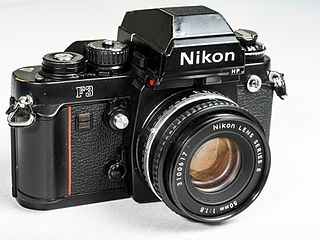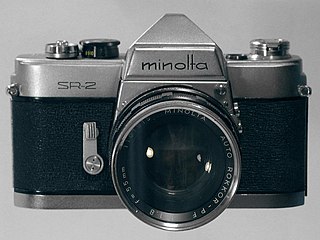
A single-lens reflex camera (SLR) is a camera that typically uses a mirror and prism system that permits the photographer to view through the lens and see exactly what will be captured. With twin lens reflex and rangefinder cameras, the viewed image could be significantly different from the final image. When the shutter button is pressed on most SLRs, the mirror flips out of the light path, allowing light to pass through to the light receptor and the image to be captured.

The Nikon F camera, introduced in April 1959, was Nikon's first SLR camera. It was one of the most advanced cameras of its day. Although many of the concepts had already been introduced elsewhere, it was revolutionary in that it was the first to combine them all in one camera. It was produced until October 1973 and was replaced by the Nikon F2. Aspects of its design remain in all of Nikon's subsequent SLR cameras, through the current Nikon F6 film and Nikon D6 digital models. The "F" in Nikon F was selected from the term "re-f-lex", since the pronunciation of the first letter "R" is not available in many Asian languages. That tradition was carried all the way through their top line of Nikon cameras until the introduction of the Nikon D1 (digital) cameras decades later.

The Exakta was a camera produced by the Ihagee Kamerawerk in Dresden, Germany, founded as the Industrie und Handels-Gesellschaft mbH, in 1912. The inspiration and design of both the VP Exakta and the Kine Exakta are the work of the Ihagee engineer Karl Nüchterlein, who did not survive the Second World War.

Minolta Co., Ltd. was a Japanese manufacturer of cameras, camera accessories, photocopiers, fax machines, and laser printers. Minolta Co., Ltd., which is also known simply as Minolta, was founded in Osaka, Japan, in 1928 as Nichi-Doku Shashinki Shōten. It made the first integrated autofocus 35 mm SLR camera system. In 1931, the company adopted its final name, an acronym for "Mechanism, Instruments, Optics, and Lenses by Tashima".

Mamiya Digital Imaging Co., Ltd. is a Japanese company that manufactures high-end cameras and other related photographic and optical equipment. With headquarters in Tokyo, it has two manufacturing plants and a workforce of over 200 people. The company was founded in May 1940 by camera designer Seiichi Mamiya and financial backer Tsunejiro Sugawara.

Praktica was a brand of camera manufactured by Pentacon in Dresden in eastern Germany, within the GDR between 1949 and the German reunification in 1990. The firm Pentacon was divided in mainly two parts and sold after German reunification. Schneider Kreuznach and Noble bought parts of it. Pentacon is a Dresden-based company in the optical and precision engineering industry, which was at times a major manufacturer of photo cameras. The name Pentacon is derived on the one hand from the Contax brand of the Dresden Zeiss Ikon Kamerawerke and Pentagon, because a pentaprism for SLR cameras developed for the first time in Dresden has this shape in cross section. Today's PENTACON GmbH Foto- und Feinwerktechnik is still based in Dresden. It is part of the Schneider Group, Bad Kreuznach. Pentacon is the modern-day successor to Dresden camera firms such as Zeiss Ikon; for many years Dresden was the world's largest producer of cameras. Previous brands of the predecessor firms included Praktica, Exa, Pentacon, Zeiss Ikon, Contax, Ica, Ernemann, Exakta, Praktiflex, and many more.
Kiev is a Soviet and Ukrainian brand of photographic equipment including cameras manufactured by the Arsenal Factory in Kyiv, Ukraine. The camera nameplates show the name "KIEV", with older cameras using "КИЕВ" or "КИЇВ" in Cyrillic.

The Pentax K1000 is an interchangeable lens, 35 mm film, single-lens reflex (SLR) camera, manufactured by Asahi Optical Co., Ltd. from 1976 to 1997, originally in Japan. The K1000's extraordinary longevity makes it a historically significant camera. The K1000's inexpensive simplicity was a great virtue and earned it an unrivalled popularity as a basic but sturdy workhorse. The Pentax K1000 eventually sold over three million units.

The Nikon F3 is Nikon's third professional single-lens reflex camera body, preceded by the F and F2. Introduced in March 1980, it has manual and semi-automatic exposure control whereby the camera would select the correct shutter speed. The Nikon F3 series cameras has the most model variations of any Nikon F camera. It is also the first of numerous Nikon F-series cameras to be styled by Italian designer Giorgetto Giugiaro, and to include a red stripe on the handgrip – a feature that would later become a signature feature of many Nikon cameras.
Jacques Bogopolsky was an engineer and camera designer.

The history of the single-lens reflex camera (SLR) begins with the use of a reflex mirror in a camera obscura described in 1676, but it took a long time for the design to succeed for photographic cameras. The first patent was granted in 1861, and the first cameras were produced in 1884, but while elegantly simple in concept, they were very complex in practice. One by one these complexities were overcome as optical and mechanical technology advanced, and in the 1960s the SLR camera became the preferred design for many high-end camera formats.
Rectaflex was the world's first series produced Pentaprism single lens reflex camera. It was produced from 1948 to 1958. Rectaflex was the only Italian single-lens reflex camera ever built.

Alpa was formerly a Swiss camera design company and manufacturer of 35 mm SLR cameras. The current owners bought the company name after the bankruptcy of the original company and the company exists today as a designer and manufacturer of high-end medium-format cameras.

Retina was the brand-name of a long-running series of German-built Kodak 35mm cameras, produced from 1934 until 1969. Kodak Retina cameras were manufactured in Stuttgart-Wangen by the Kodak AG Dr. Nagel Werk which Kodak had acquired in December 1931.

Half-frame cameras, also called single-frame or split-frame cameras, are film cameras compatible with 35mm film types. These cameras capture congruent shots that take up half of each individual frame in the roll of film. They can be still frame or motion picture cameras and are the standard format of 35mm movie cameras. This is commonly expressed, more technically, as 18×24 mm using 18×24 mm of a regular 135 film. It is closer to the normal frame size of a 35 mm motion film. This leaves half frame cameras to derive their film plate size from the aspect ratio, and frame size that was first designated by Thomas Edison at the dawn of the motion picture industry. Traditionally, the additional film width on motion picture film is used for audio in later film standards, although the original patent for sound on film is derived from the 1880s.

The Auto-Reflex and Autoreflex is a series of 35mm SLR cameras made by Konica from 1965 to 1988. All these models have the Konica AR bayonet.

The Mecaflex is a 35mm SLR camera for 50 exposures of 24 × 24 mm. It was presented at the photokina in Cologne in 1951, and launched commercially about two years later. The design is by Heinz Kilfitt, who is also known for designing the original Robot camera and the Kowa Six.

The "Sport" camera is the series production model of a prototype camera called Gelveta. The Gelveta was designed and built by A. O. Gelgar between 1934 and 1935. It is the earliest known production 35mm SLR camera ever to be built, but fewer than 320 examples were made. The actual launch date of the "Sport" is somewhat uncertain, however it was in series production by 1936 and must undoubtedly be one of the two earliest generally available SLR cameras using the 35mm film format, the other being the German Ihagee Kine Exakta, launched in 1936. It was manufactured by the Soviet camera factory Gosudarstvennyi Optiko-Mekhanicheskii Zavod, The State Optical-Mechanical Factory in Leningrad. GOMZ for short. The camera name is engraved in Cyrillic on the finder housing above the lens: „Спорm“. The manufacturer's prism logo in gold on black with the factory initials ГОМЗ (GOMZ) is shown behind a circular magnifying window on the top left camera front. An estimated number of 19,000 cameras were made before Leningrad was besieged in September 1941 and suffered heavy damage. The design concept was not continued later.

The Topcon RE Super, or Beseler Topcon Super D in USA, was launched by Tokyo Kogaku KK in 1963 and manufactured until 1971, at which point it was upgraded to the Super D and again to Super DM the following year. General sale continued for several years. These later models have a shutter release lock lever on the shutter release collar. It is a professional oriented 35mm SLR camera that had a comprehensive range of accessories available. It has a removable pentaprism viewfinder and focusing screen. It features the Exakta bayonet lens mount for interchangeable lenses. A special accessory shoe is situated at the base of the rewind knob with a standard PC sync. contact next to it. The release button is placed at the right-hand camera front, but there is no mirror-up facility; this was included on the upgraded versions. The standard lens is the RE. Auto-Topcor 1:1.4 f=5.8cm or the slightly slower 1:1.8 version. A battery-operated winder could be attached to the camera base.

The Minolta SR-2 was presented in 1958 as the first 35mm SLR camera from Chiyoda Kogaku. Popular cameras of this type at that time were mainly from Europe but a few from Japan, including the Asahi Pentax, the Miranda T and the Topcon R. The miniature SLR camera concept was conceived in the 1930s at Ihagee in Dresden, resulting in the 1936 Kine Exakta. Influential cameras designs like that of the 1939 KW Praktiflex, the 1949 ZI Contax S, and 1952 the KW Praktina marked the steady progress toward a perfected SLR. Several features of the latter seem to have influenced the design of the SR-2 although dissimilar in many respects. The obvious similarities are the stepped top plate, the carrying strap lugs, the self-timer lever and some general body features.


















